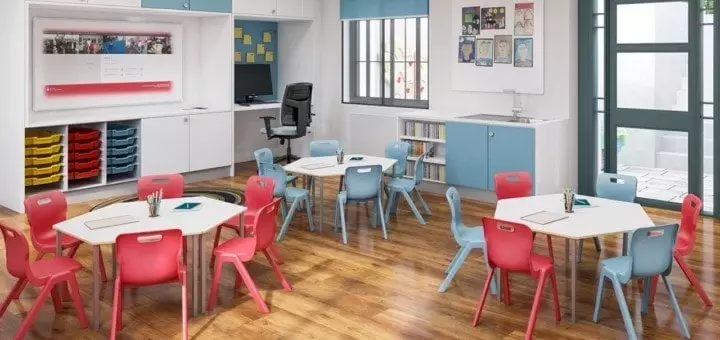Primary school furniture has a profound impact on young students. Research shows that furniture designed specifically for children not only supports learning and focus but also improves posture, enhances creativity, and ensures safety. While adult desks and chairs work fine for older students, equipping primary classrooms with age-appropriate furniture is crucial for 6 to 12 year olds. This article will explore the types of furniture ideal for primary schools, top suppliers and brands, trends, classroom layout considerations, maintenance tips, and innovations on the horizon. Whether you’re an educator outfitting a new classroom or a parent curious about the furniture your child uses daily, you’ll learn why primary school furniture matters and how to choose pieces to benefit students.
## History and Origins
The specialized market for primary school furniture suppliers first emerged in the early 20th century, as formal primary education became widespread and classroom design evolved. Before this time, most schools utilized basic furniture like benches and writing slates.
As child-centered philosophies of education gained prominence in the late 1800s, classroom design began incorporating more age-appropriate, adjustable and modular furniture. Companies started manufacturing specialized desks, chairs, bookcases, and storage units tailored to primary schools. These early suppliers focused mainly on durability and utilitarian design.
Key innovations that shaped the primary school furniture industry include:
– Development of curved desks and chairs to fit young bodies better (1910s)
– Use of laminate surfaces for easy cleaning (1930s)
– Introduction of plastic furniture with bright colors and ergonomic shapes (1950s/60s)
– Focus on adjustable and flexible modular designs (1970s)
– Shift towards active learning environments with seating arrangements that enable collaboration (1990s-present)
Over time, health and safety standards improved, requirements for accessibility increased, and a greater emphasis was placed on appealing aesthetics. Durable yet lightweight materials also enabled more flexibility and mobility in classroom layouts. Environmental sustainability has become a priority for many suppliers and buyers in recent years as well.
Today’s primary school furniture suppliers cater to a diverse range of needs – from traditional seated desks to innovative arrangements like stand-up desks, floor seating, and room dividers. The market continues to evolve along with educational philosophies and technologies.
## Types of Furniture Needed
Elementary school classrooms require a variety of furniture to meet the needs of students and teachers. Here are some of the most common types of furniture found in primary schools:
### Desks and Chairs
Student desks and chairs are essential for providing each child with their own dedicated workspace. Desks should be sized appropriately for the grade levels using them. Ergonomic chairs that support developing spines are important. Many schools choose desk and chair sets with adjustable heights to accommodate growth.
### Bookshelves
Low, open bookshelves accessible to students encourage self-directed learning. Having places to store books, learning materials, and projects in progress helps keep classrooms organized.
### Storage Cabinets
Locking cabinets provide secure storage for teacher supplies and confidential student records. Open shelving units neatly organize everything from art supplies to science equipment. Sturdy cabinets stand up to frequent daily use.
### Specialty Furniture
Unique furniture supports specific learning activities. Stand-up desks allow students to alternate between sitting and standing. Small group tables facilitate collaborative work. Computer workstations and media carts incorporate technology. STEM and art centers require appropriate furnishings as well.
## Considerations in Choosing Furniture
When selecting primary school furniture, there are several key factors schools and educators should consider:
### Durability
Furniture for primary school classrooms needs to stand up to heavy daily use by young children. It should be made from sturdy materials like hardwoods, metals, and durable plastics that can withstand constant activity, movement, and cleaning. Avoid furniture made from lower quality or composite woods that are prone to scratches and dents.
### Cost
With school budgets often tight, cost will likely play a role in choosing new classroom furniture. Seek a balance between affordability and long-term durability. Higher quality furniture may cost more upfront but save in replacement costs over time. Consider multi-use, versatile pieces to maximize value.
### Adjustability
Look for furniture like desks and chairs that can be adjusted to properly fit students of different heights and sizes. Adjustable desks allow students to alternate between sitting and standing. Chairs with adjustable seats and height settings provide ergonomic support.
### Mobility
Wheels and casters allow children and teachers to easily rearrange desks and seating to switch up the layout. Lightweight yet sturdy furniture enables classrooms to be reconfigured for different learning activities.
### Storage
Incorporating storage like shelves, cubbies, and bins maximizes space and keeps classrooms organized. Storage options allow students to access learning materials and safely stow backpacks, coats, and projects.
### Comfort
Students are most attentive when they are comfortable. Well-padded chairs, appropriate desk and table heights, and suitable workspace sizes all contribute to comfort. Adequate circulation space reduces crowding.
### Safety
Rounded corners, appropriate table edge heights, secure shelves/hooks, and tip-resistant seats are some safety features to look for in primary school furniture. Non-toxic, durable finishes ensure children’s health.
## Leading Suppliers
The primary school furniture supply industry has several major players that educational institutions turn to when outfitting their classrooms and facilities. Here are some of the leading suppliers in the market:
### ABC School Furniture
Founded in 1955, ABC School Furniture is one of the oldest and most trusted names in classroom furniture. Headquartered in Ohio, ABC serves over 5,000 K-12 schools across the United States. They offer a wide selection of desks, chairs, shelving units, and storage solutions made from high-quality materials like solid wood and steel. ABC sets itself apart with its lifetime warranty on most products, to give buyers peace of mind.
### Acme Furniture Corp
Acme Furniture has been equipping schools since the 1960s. Based in New York, they partner with designers to offer ergonomic and adaptable options tailored to educational environments. Acme is best known for its innovative [Safe-Stor](https://example.com) student cubbies that securely store backpacks, coats, and personal items. These cubbies save space and promote organization. Acme also offers seating, desks, and STEM lab furnishings.
### Classroom Essentials
This Midwest-based company focuses entirely on K-12 educational furniture and prides itself on durable and budget-friendly options. Classroom Essentials’ inventory includes flexible seating like wobble stools and scoop rockers to enable movement during learning. They also sell teacher desks, bookcases, and round activity tables sized for children. Bulk pricing and volume discounts make them popular with school districts.
### Furniture Associates
With 50+ years in the school furniture industry, Furniture Associates offers a huge selection of products for classrooms, libraries, cafeterias, lounges, and administration. This company’s ergonomic chairs foster healthy posture for students and teachers. Furniture Associates is commited to eco-friendly practices and uses recycled materials in their production process. They frequently introduce new innovations in educational furniture design.
## Buying Trends
When it comes to buying primary school furniture, there are a few key trends to be aware of. Comfort and flexibility have become priorities, with furniture that can be easily rearranged and provide options for sitting or standing. This supports modern teaching methods focused on collaboration and engagement.
Ergonomic furniture is also popular, as schools aim to support proper posture and comfort for young students. Chairs with adjustable heights and desks with sloped surfaces are common. Natural materials like wood are preferred for their warmth and durability.
In terms of style, bright colors and rounded edges are prevalent in primary schools. Furniture with a modern, clean aesthetic fits well into the cheerful environment. Whimsical accents like animal cut-outs or nature-inspired patterns also appeal to young children.
For storage and organization, mobile pegs, cubbies, and shelving on casters provide flexibility. This allows teachers to rearrange storage as needed. Durable plastic bins in primary colors are commonly used. Storage furniture is designed at kid height and incorporates handles or hooks for ease of use.
When outfitting a primary school, buyers should look for quality, comfortable furniture in bright, warm styles that can adapt to the needs of active young students. Aim for an uplifting, modern environment well-suited for positive learning experiences.
## Setting Up the Classroom
When setting up a primary school classroom, furniture placement and layout are key for creating an effective learning environment. Here are some tips for optimal classroom layout and furniture placement:
– Make sure there are clear walkways so students can move around the room without obstruction. Leave space between desks and reading areas.
– Place the teacher’s desk at the front of the room but off to one side. This allows the teacher to oversee the class while not acting as a physical barrier between them and the students.
– Organize desks into clusters, rows, or a semi-circle to encourage student discussion and collaboration. Avoid separating desks too much.
– Set up reading areas with carpet and pillows to make them inviting and comfortable. Place bookshelves nearby.
– Display student work on the walls and bulletin boards around the room to promote a sense of ownership and accomplishment.
– Put supplies, toys, and learning manipulatives on accessible shelves so students can retrieve them independently. Label containers clearly.
– Make sure the classroom setup meets any special needs, with desks set up for left-handed students, assistive technology, and clear paths for wheelchairs if necessary.
– Arrange desks and seating to take advantage of natural light from windows, and position active learning zones away from quiet reading areas.
– Allow room near electrical outlets for devices, lamps, and other technology. Extension cords can create tripping hazards.
With some planning and forethought, teachers can create primary school classrooms that effectively support different learning activities and make children feel welcome. The layout should maximize engagement, collaboration, and independence.
## Maintenance and Care
Keeping classroom furniture clean and safe for students is crucial for a productive learning environment. Regular maintenance and care of primary school furniture will prolong its life span and prevent injuries.
Teachers and staff should inspect all furniture weekly for any loose parts, breaks, tears or other safety hazards. Take note of any issues and remove damaged furniture from the classroom if it poses a risk. Arrange repairs through your furniture supplier.
Clean furniture surfaces frequently to avoid buildup of dirt, germs and clutter. Use a mild, non-toxic cleaner and microfiber cloths. Don’t use abrasive cleaners or scouring pads which can damage finishes. Anti-bacterial wipes can disinfect tables, chairs and desks.
Pay attention to high-touch areas and clean at least once a day. Use sticky roller brushes for fabric upholstery to remove debris and lint. Vacuum fabric and use upholstery cleaners monthly.
Limit food and drinks to designated areas to prevent stains. Deal with spills right away by blotting up liquids and spot cleaning. For tough stains, use a targeted stain remover safe for classroom use.
Organize maintenance checks before each term and a thorough deep clean during breaks when classrooms are empty. Take stock of needs to replace aging or unsuitable furniture. Regular care will facilitate a secure, clean environment.
## Looking Ahead
The future of primary school furniture is an exciting topic, as new innovations and trends continue to emerge. Here are some key developments we can expect to see in the years ahead:
### Focus on Flexibility and Mobility
Classroom layouts and furniture will become even more flexible and movable to accommodate different teaching methods, group work, and learning stations. Lightweight chairs on wheels, movable tables, modular furniture pieces and writable surfaces throughout the room will allow teachers to reconfigure spaces quickly and easily.
### Emphasis on Collaboration
More furniture will be designed to support group interactions, with circular tables, comfortable seating areas, whiteboards for brainstorming and multimedia workstations to bring out collaboration. The traditional row by row desk arrangement will continue to decline in favor of flexible options.
### Active Learning Friendly
Furniture will adapt to promote movement and activity, rather than static sitting. Standing desks, bouncy chairs, floor mats and movable pieces allow students to learn in the postures that best suit them. Natural lighting, color schemes and open spaces also contribute to an active environment.
### Focus on Health and Wellbeing
With a greater awareness of ergonomics and children’s developmental needs, schools will select furniture to support posture and comfort. Tables and chairs will be height adjustable, allow for proper alignment and encourage good sitting habits early on. Eco-friendly materials will also gain favor.
### Integrated Technology
From interactive whiteboards to classroom tablets and built-in charging stations, technology integration will be central to furniture design. Pieces will seamlessly incorporate the latest educational technologies and school management software.
### Customization
Mass produced classroom furniture will move towards customization, so that schools can select pieces tailored to their needs and students. Modular components, different table shapes and seats, a variety of materials and school-specific branding/logos will be common options.
By embracing these innovations, schools can create next generation learning environments that truly optimize the classroom experience.
## Conclusion
Furnishings for young students are a critical component of their learning environment. In this article, we explored the different types of furniture needed in primary schools today, key factors to weigh when selecting pieces, top suppliers to consider, and best practices for setup and care.
To recap, desks, chairs, bookcases, and storage cabinets form the core classroom furniture types. Key considerations include durability, adjustability, comfort and design suited for small children. Leading global suppliers known for school-specific furniture include VS America, Smith System, and Virco. Setting up the space thoughtfully, maintaining cleanliness, and ensuring proper repairs will help extend the life of the furnishings.
Looking ahead, flexible, movable furniture and layouts will continue gaining favor, as research shows this facilitates collaboration and learning. Technology integration also points toward more desks with power outlets and furniture that can hold devices. While trends may shift, the furniture’s role in providing an engaging, inspiring and ergonomic space for students will remain constant. The furnishings we choose for the next generation shape their educational experience and development.









